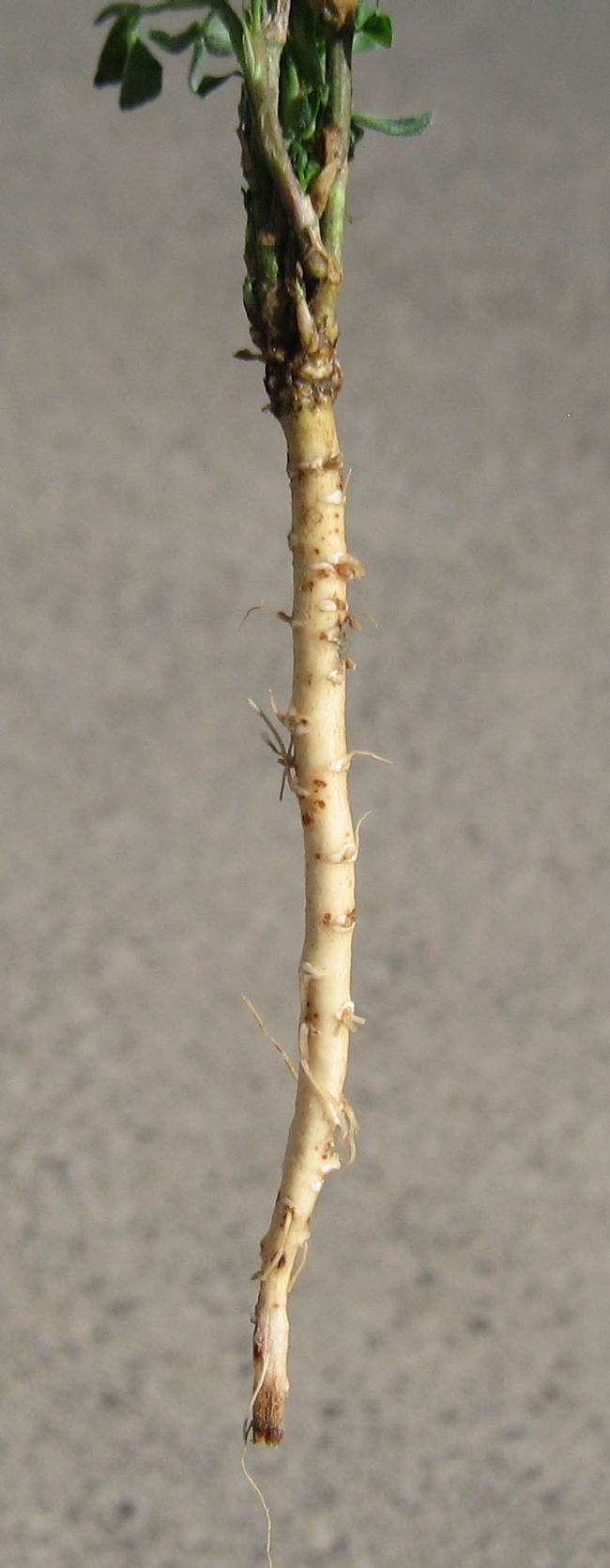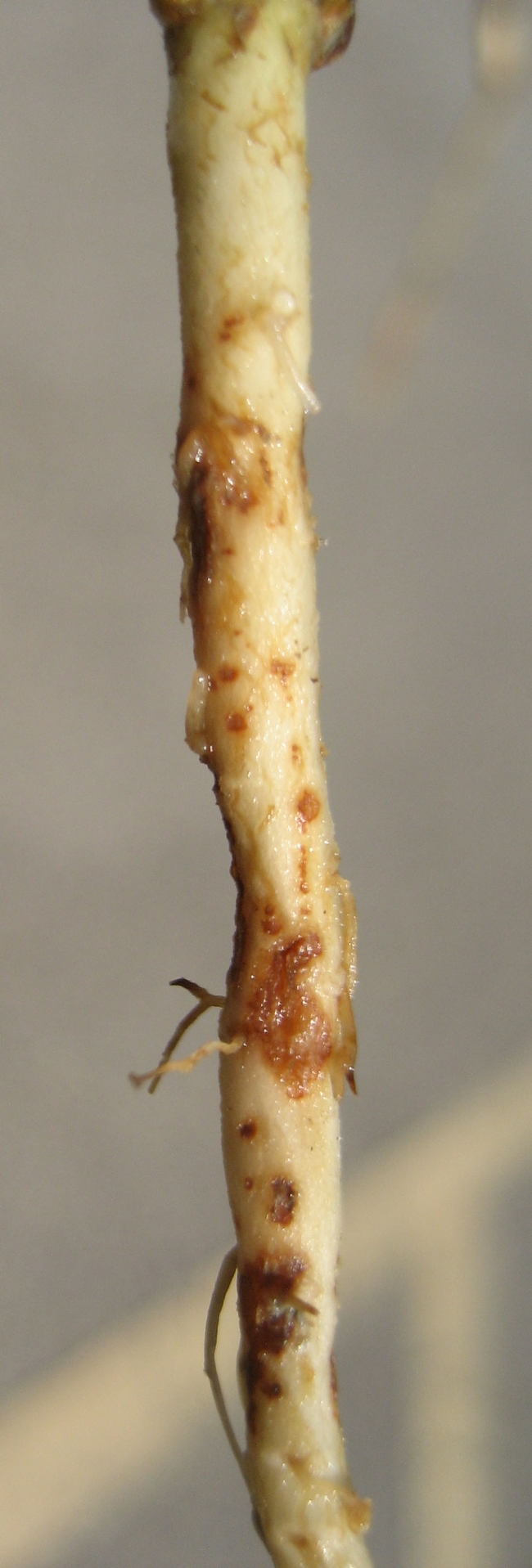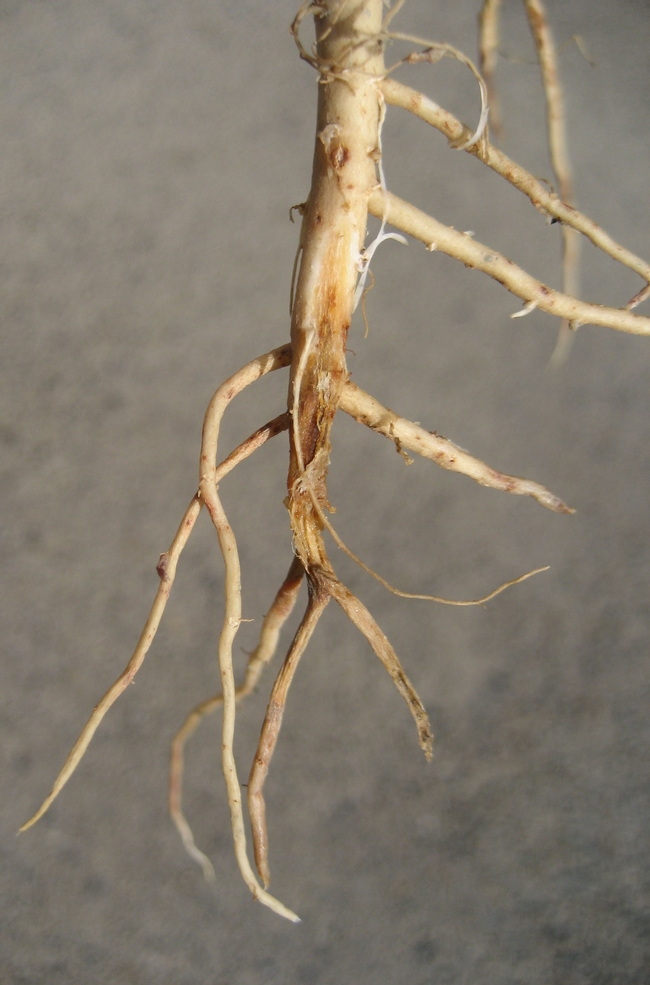- Author: Carol A Frate
Many of us think about too much water killing alfalfa during the hot days of summer. And this does happen, especially at the tail end of fields where water may collect and stand for hours after the irrigation has ended. When temperatures are over 100 oF and the soil is saturated for extended periods, roots can essentially suffocate due to lack of oxygen. Plants die very quickly and roots begin to disintegrate. Because the root zone is usually saturated from the soil surface for a depth of several inches or even feet, the entire root rots. This situation is referred to as “scald” and is a physiological process rather than a pathology process.
There is another situation where saturated soil leads to dead alfalfa but in this case a fungus, called Phytophthora megasperma f. sp. medicaginis, is involved. This soil-inhabiting fungus requires saturated soil conditions for infection to occur. Infected plants are most likely to be found in fields with clay soils, soils with poor drainage, long irrigation sets, or when any condition causes water to stand in the soil for a long time. Sometimes the saturated soil condition is not obvious – the soil surface may be dry but, some distance below the surface, soil can be saturated due to soil type (heavy clay) or an impediment to drainage such as a hardpan. Because the disease requires saturated soils, Phytophthora-infected plants are often located at the tail end of a field but they can be found anywhere in a field when the right conditions occur.
While the “scald” mentioned in the first paragraph is only found in the high heat of summer, the optimum soil temperatures for infection by Phytophthora are 75-82 oF. It is in the spring months (late March – May) that I have seen the highest levels of Phytophthora root rot. This past April I saw a field with infected plants throughout the field. It was planted this past winter and the foliage was 6 to 12 inches high. Ten to fourteen days before I saw it, the field was flood irrigated. The heavy clay soil took water like a sponge – possibly a reflection of how dry the soil was due to the lack of rain this winter. I could easily walk on the field but about 4-5 inches below the surface the soil was essentially mud.
Above ground, the plants on the levees were a nice green and had no symptoms (which is often the case when wet soil is contributing to alfalfa root problems). Between the borders, plants with tan-colored, dried leaves were scattered throughout the check, although they were more prevalent at the tail end. Many plants were dead. Beneath the soil surface, the portions of the roots that were in the upper part of the soil, where the soil was not saturated, appeared healthy (Photo 1) or at worst had small brown sunken spots (lesions) scattered on the roots (Photo 2). Lower on the roots, where they were in contact with saturated soil, root tissue had died and was rotting. On some infected plants, larger-than-normal lateral roots had developed on the healthy portion of the root above the rot (Photo 3). Often laterals like these can compensate for the loss of the tap root but they will never grow vertically and as deep into the soil as a healthy tap root. The result is a compromised root system and reduced production in summer because these plants can’t use water from lower in the soil profile when irrigations can't keep up with crop requirements or are delayed due to harvest operations.






thanks for a response
Joe
The pattern of Phytophthora in a field is dependent on where the water stands so, if the circles you mention correspond to an area where water puddles or stands - or it is the pattern of a clay soil type, then circles wouldn't be unusual. In our case, where the land is usually leveled with a laser, Phytophthora often appears at the tail end of the irrigation run where water may stand for some time, or where there are unintended low spots, or to parts of the field where there are drainage problems due to soil type or compaction. Circles aren't necessarily the norm but certainly could happen.
The key to further identifying if the problem is Phytophthora is to look at the roots when the plants are wilting and in the process of dying - not after they are dead. Cut the root open and see if there is discoloration internally in the root. I would be happy to look at any photos that you send.
In any case, you should probably try to choose an alfalfa variety with as much resistance to Phytophthora as possible. Rotating out of alfalfa in some of your fields for a year or two might be helpful to the overall health and production of your crop. (Rotation however won't do much to reduce Phytophthora because the fungus survives quite well in soil for a long time).
I am familiar with alfalfa diseases in California but there may be diseases in your part of Texas with which I am not familiar. You might want to check the the Texas A&M website http://plantdiseasehandbook.tamu.edu/industry-specialty/forage-crops/alfalfa-and-sweet-clover/ , which has information on alfalfa and clover diseases in Texas. There is one disease Phymatotricum omnivorum (cotton root rot disease). It is known for appearing in circles and is limited to soils with a pH above 7 and in areas with high soil temperatures. It is most often found in the southwest so I am not sure if this disease is an issue where you are located.
With the classic Blackland Clay soil slow water infiltration Phytophthora is a known problem.
I select varieties that have HR resistance to PRR.
At an AFGC Conference DR Warren Thompson mentioned that if we really need good resistance for PRR then also select for Aphanomyces resistance. For some reason that helps. In 2007 we had a very wet season and Warren Thompson's comment proved correct.
Obviously I now select for both PRR & Aphanomyces resistance.
I have found, for Central Texas, the Alfalfa weevil is less of a problem with FD 4 varieties.